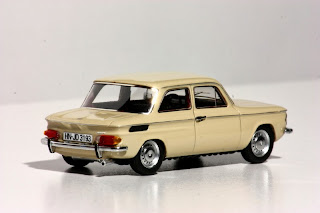The NSU Typ 110 was a small car first presented at the 1965 Frankfurt Motor Show, widening NSU’s range in the process. It was based on the NSU Prinz 1000 but with a longer wheelbase and a front overhang which increased available space both in the passenger cabin and in the luggage compartment. With an external length of four metres the car took NSU into the lower rungs of the middle class saloon sector, as it existed at that time in West Germany. It was to distance the model from the small car sector that for this model NSU abandoned the Prinz name which had till then been carried by their passenger cars.
Viewed from the front, large rectangular headlights differentiate the Typ 110 from the smaller models, flanking a large chrome-effect panel that might have passed for a false grill. Inside, domestic market cars featured a fashionable strip speedometer reminiscent of that found on the Opel Rekord B which had been introduced a couple of months earlier. The Typ 110 came with a strip of 'simulated wood' veneer across the width of the dash board, while a new heating and ventilation system testified to the car’s middle class aspirations. Reclining front seats were available at extra cost.
The Typ 110 and the Prinz 1000 were powered by rear-mounted air-cooled four-cylinder engines. These were noted for their relatively advanced configuration for the times, being mounted transversely and having a chain-driven single overhead camshaft with an inline-mounted distributor. Initially the Typ 110 came with a 1085 cc engine with a claimed output of 39 kW (53 PS; 52 hp), which would also find its way into the sporting smaller Prinz 1000 TT, albeit with a slightly higher claimed output of 40 kW (54 PS; 54 hp). During early 1967 a larger engine of 1,177 cc 44 kW (60 PS; 59 hp) became available in a version designated as the NSU Typ 110SC.
The independent rear suspension design was of semi-trailing arm configuration and, similarly to most of the body and floor pan structure aft of the A-Pillar, was shared between the 1000 and Type 110. However, the front suspension of the Typ 110 was a new double-wishbone design with longer wishbones, better noise isolation and longer wheel travel than those of the 1000 models.
Later in 1967 NSU simplified their model range. The NSU Typ 110 was rebranded as the NSU 1200, with claimed engine output now reduced back to 40 kW (54 PS; 54 hp). In this form it continued to be offered in Germany until December 1972.
The Typ 110 was unusually easy to repair, with care taken to ensure easy replacement of key components: it was claimed that the entire clutch could be changed in just 30 minutes. Zinc coating on the under body promised superior rust resistance. Recommended service intervals of 7,500 kilometres (4,700 mi) at a time when competitor vehicles typically required a routine service every 5,000 kilometres (3,100 mi) also gave the car an advantage in a cost conscious market place, and pointed to a future when less than a decade later NSU's new parent company, Volkswagen would lead the way in extending recommended service intervals to 15,000 kilometres (9,300 mi) with their new front engined ranges.
+(01).jpg)
+(02).jpg)
+(03).jpg)
+(04).jpg)
+(05).jpg)
+(06).jpg)
+(07).jpg)
+(08).jpg)
+(09).jpg)
+(10).jpg)
Technical data:
- engine: 4 cylinders
- capacity: 1177 cc
- horsepower: 60 HP
- gearbox: 4+1
- top speed: 140 km/h

1 komentarz:
Very beautiful NSU creme colour of Neo.
Hughs!
Prześlij komentarz